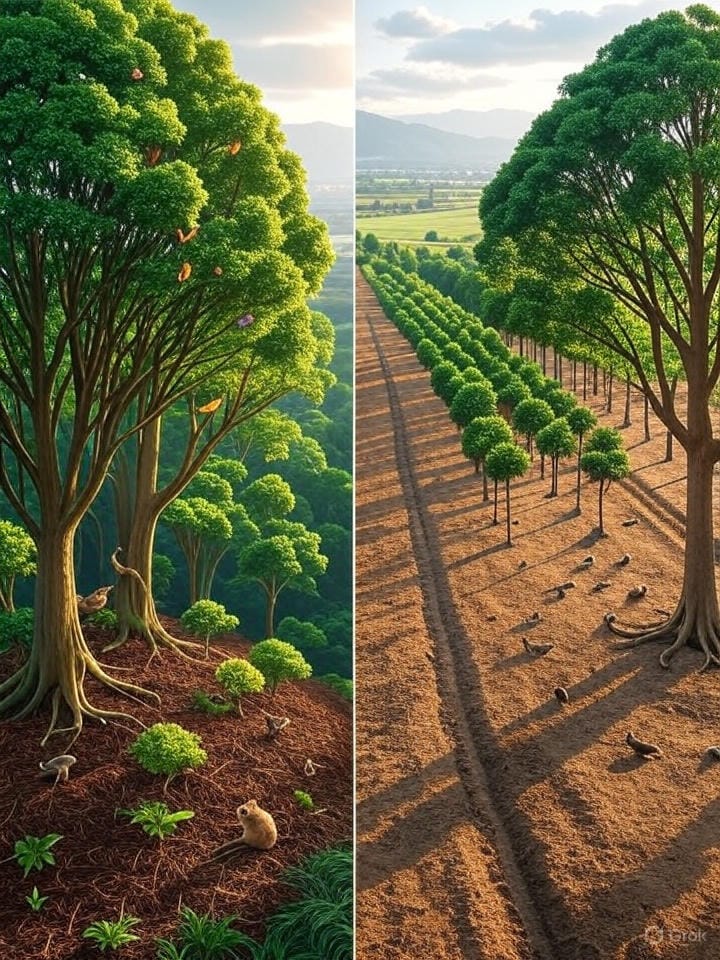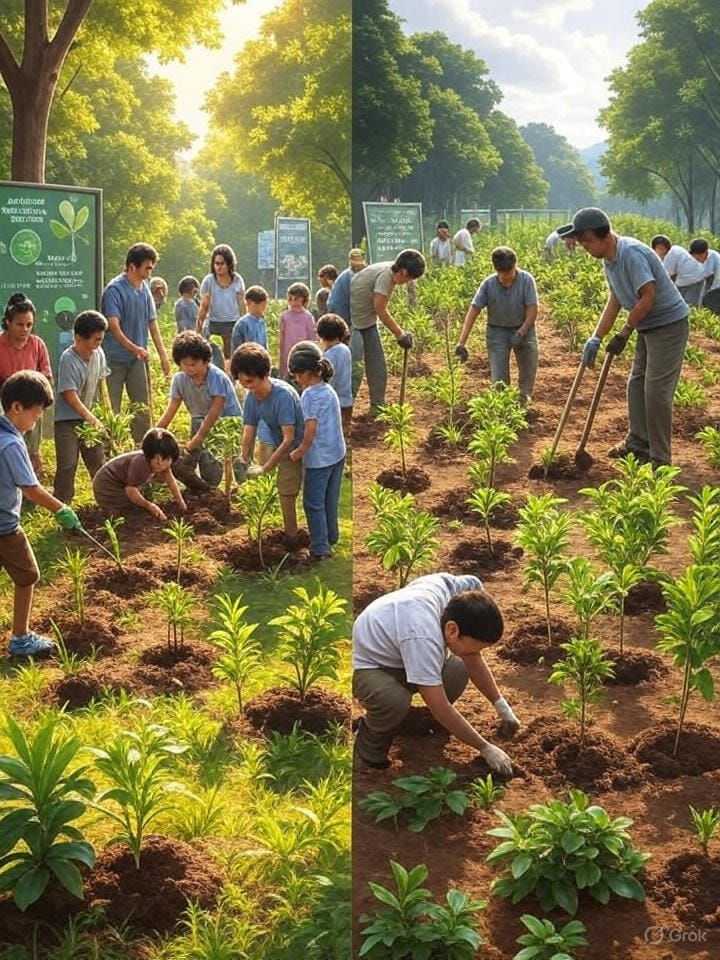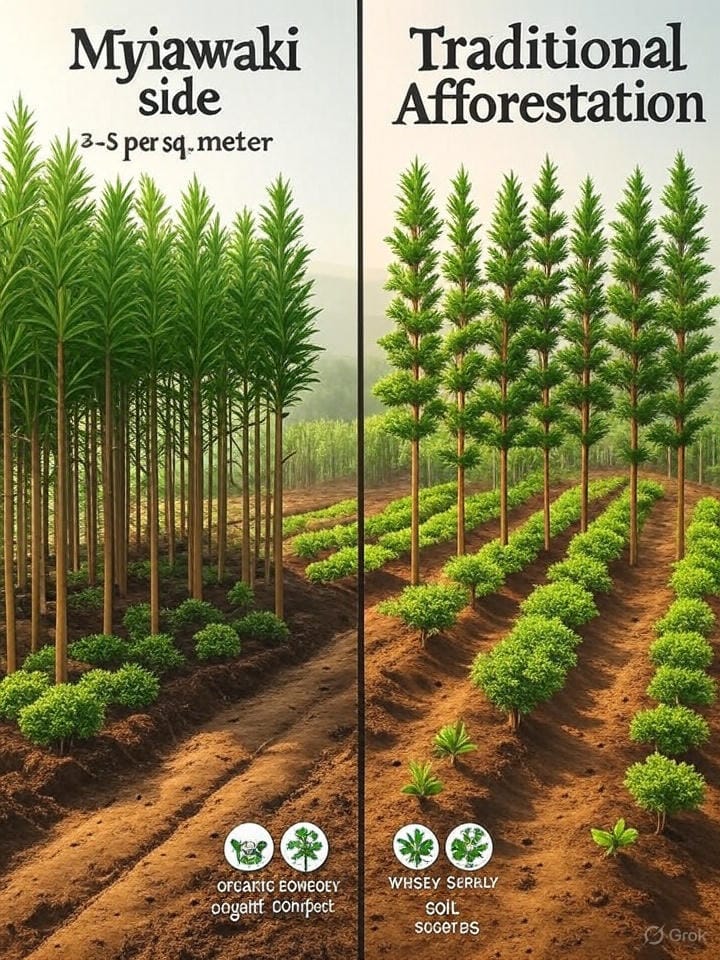
Table of Contents
ToggleMiyawaki method vs traditional afforestation
In modern days, afforestation is the most reliable strategy to counter deforestation, climate change, and biodiversity loss. By then two primary approaches have emerged globally—the traditional afforestation method and the Miyawaki method. Both methods have a common goal to restore greenery. Yet their philosophy, pace, and ecological outcomes differ significantly.
Traditional afforestation generally relies on sparse & large-scale planting of a single or a few species. They’re often selected for economic or timber value. Such forests are slower to mature and often lack the ecological resilience that is necessary to support a diverse range of flora and fauna. Moreover, these limitations cannot stop traditional planting. It has been widely adopted because of its scalability across vast degraded landscapes.
On the other hand, the Miyawaki method, which was developed by Akira Miyawaki, emphasizes dense planting of diverse native species in a small area. It mimics natural forest growth and achieves the maturity of a century-old forest within just two or three decades. These forests provide rich biodiversity and sequester carbon more efficiently which overall makes them valuable in urban and semi-urban areas.
The debate is no longer about planting more trees; now it’s about how we plant them. Every nation is trying to secure sustainable climate resilience, and hence evaluating effectiveness, adaptability and ecological impact has become more critical today.

Method comparison of Miyawaki and traditional afforestation
To understand the difference between Miyawaki and traditional afforestation we have to look closely at how each method is applied. Here’s Miyawaki method vs traditional afforestation in methodological perception:-
Miyawaki method
- Dense planting: 3-5 saplings are planted per square metre to ensure intense competition and faster vertical growth.
- Diversity of Species: It focuses on 20–40 native species that replicate the natural forest composition of the region.
- Soil Bio-engineering: organic matter, mulch and microbial inputs are added to enrich the soil and accelerate natural growth.
- Rapid Growth: Forests often become self-sustaining within 2-3 years and can mature 10 times faster than traditional plantations.
Traditional Afforestation
- Sparse Planting: Trees are planted at wider intervals so that competition for resources can be reduced.
- Limited Species Variety: They are often dominated by a few commercial or fast-growing species, which can create monocultures.
- Minimal soil preparation: Basic tilling or put digging is done. No extra focus on soil enrichment.
- Slower Development: it may take decades for plantations to become natural forest ecosystem.
Key Ecological Principles and Conclusion
The Miyawaki method mimics natural vegetation and aims for maximum biodiversity and resilience. In contrast, traditional afforestation methods prioritize practicality and large-scale coverage, but the ecological functionality is reduced.
So in short, the miyawaki method focuses on speed, diversity, and the ecosystem’s health, whereas traditional afforestation emphasizes scale and simplicity. Both approaches carry value, but their effectiveness depends on land availability and long-term goals.

Ecological impact Comparison
The ecological outcomes of afforestation methods extend beyond tree count. They influence biodiversity, carbon capturing, and soil health- all of which are critical factors for evaluating long-term effectiveness. Here’s Miyawaki method vs traditional afforestation under ecological impact :-
Biodiversity
Miyawaki forests can host insects, birds and small mammals with 20-40 native species within a few years. It creates a micro-ecosystem even in urban spaces. On the other side, traditional Forests often fail to support rich biodiversity due to monoculture plantations or limited species. They leave ecosystems vulnerable to pests and diseases.
Carbon Sequestration
Dense plantings under the Miyawaki method lead to rapid biomass accumulation. They can sequester carbon up to 10-30 times faster in the first two decades compared to traditional plantations. In traditional afforestation carbon absorption occurs more gradually. They are effective over large areas, but their slower pace may not address the urgency of climate mitigation needs.
Soil Health
By the Miyawaki method, we can enrich the soil through organic matter, which helps to improve microbial activity, water retention, and nutrient cycling. As a result a healthier ground cover is formed. However, in the traditional method, minimal soil preparation may result in compacted soils and weaker root networks that cause slower ecosystem restoration.
Global Biome Adaptability
The Miyawaki method has been proven successful in tropical and temperate zones, especially in degraded or urban lands, whereas the traditional method is more adaptable at the continental scale. It is suited for large arid or semi-arid landscapes where miyawaki density may not be feasible.
Overall, the Miyawaki method offers a faster ecological return, and traditional afforestation remains practical for vast land regeneration. Moreover the effectiveness of each method depends on biome, scale and restoration goals.
Economic and social feasibility
If afforestation projects succeed then they not only win on ecological grounds but also on their economic practicality and social acceptance. Here’s Miyawaki method vs traditional afforestation to highlight their distinct trade-offs:-
Cost-Benefit Balance
Miyawaki forests require higher initial investment due to soil preparation, dense planting and species diversity. However, its maintenance costs drop significantly after 2-3 years because the forest becomes self-sustaining. Traditional plantations are less costly because soil enrichment is minimal and fewer species are used. Yet the ongoing inputs like irrigation, pesticides, or replanting may add to long-term expenses.
Community Involvement
The Miyawaki method is often implemented in small patches within urban and peri-urban areas. This feature makes them ideal for community participation, awareness programs, and local stewardship. The traditional method is applied for large-scale rural projects to provide employment, but it involves less active citizen engagement.
Scalability
Miyawaki method is best suited for compact plots, city parks, schoolyards and degraded lands where rapid results are needed. But scaling this method to thousands of hectares is challenging due to the higher cost and density. The traditional method is easier to replicate across vast landscapes, which makes it useful for government-operated afforestation projects or carbon-offset programs.
Hidden Costs and Maintenance
Watering and protection are critical in the first 2 years under the Miyawaki method. After that, you can decrease the rate as forests become self-sustaining. On the other hand, traditional afforestation requires long-term monitoring due to slow growth. Their plantations are also vulnerable to grazing, fire and neglect.
In simple words, miyawaki offers high-impact but it is a localised solution, whereas traditional afforestation delivers large-scale coverage with a slower growth rate. In my opinion, an integrated model may provide the best balance of economy and ecology.

Global case studies of Miyawaki method and traditional afforestation
According to the U.S. Environmental Protection Agency (EPA), forests play a critical role in absorbing greenhouse gases and mitigating climate change impacts. Examining how different nations have adopted afforestation methods can offer us a valuable insight into the global effectiveness of both methods. Miyawaki method vs traditional afforestation, which one has dominance across the world:-
Japan – Origin of the Miyawaki Method
As we know, the miyawaki technique was invented in Japan to restore degraded temples and industrial lands. Today, thousands of miyawaki forests exist across the country to demonstrate resilience against typhoons and heavy rainfall. They are offering urban green lungs.
India – Urban Micro-Forests
Indian cities like Chennai, Bengaluru, and Delhi have implemented Miyawaki plantations in schools, parks, and residential areas. These projects have rapidly created biodiversity pockets. But still, many critics argue that extremely dense planting may not allow long-term canopy formation in some ecosystems.
Europe – Traditional Afforestation for Scale
European countries like Spain and France have continued large-scale afforestation by using traditional methods. They often use commercial species such as pine or eucalyptus. This method is effective in restoring ground cover, but monoculture can lead to biodiversity loss and higher vulnerability to forest fires.
Africa – Mixed Approaches
The African continent is using mixed approaches. In Kenya and Ethiopia, traditional tree planting campaigns focus on combating desertification, and experimental Miyawaki projects are being tested in urban and semi-arid zones for quicker ecological return.
Adaptability Insights
Miyawaki method is highly adaptable in small, degraded or urban plots worldwide. The traditional method is better for vast landscapes, especially in semi-arid or rural regions. Moreover, global experience has suggested that a hybrid approach can maximize resilience and effectiveness.
Challenges and criticisms of Miyawaki and traditional method
Miyawaki method and traditional afforestation are popular, but they still face notable criticisms that question their long-term effectiveness. The Miyawaki approach is praised for its speed and biodiversity potential, but at the same time, it’s often criticized for being resource-intensive. Preparation of soil, collecting a wide variety of native saplings, and ensuring Intensive care during the first 2 years demand financial and logistical resources.
All these issues make the method difficult to scale beyond small plots, especially in countries where land availability and budgets are limited. Moreover, many ecologists argue that planting dozens of species in a dense pattern may not always align with the natural composition of local ecosystems. Maybe these artificial densities disrupt long-term forest dynamics and result in imbalanced growth or limited canopy development.
On the next side, traditional afforestation is frequently criticized for its slow pace and ecological simplicity. Large plantations are often dominated by a single or a few species. They are just like resembling tree farms rather than being functional forests. Such monocultures provide limited habitat value, reduce resilience against pests & diseases. They can also fail to restore ecological cycles. Due to a slow growth rate, they require decades to contribute to the environment.
Both methods present trade-offs: Miyawaki forests are fast but limited in scalability whereas traditional afforestation is expensive but ecologically weaker.
FAQs
How does miyawaki method is different from traditional afforestation?
The Miyawaki method emphasizes dense planting of diverse native species. Their growth rate is faster and it gives a rich biodiversity. Traditional afforestation usually involves sparse planting with limited species variety which grows more slowly and they can create monocultures. Miyawaki method vs traditional afforestation, Miyawaki is far ahead in terms of biodiversity.
Is miyawaki method vs traditional afforestation speed comparison really significant?
Yes, speed is the most important factor for the miyawaki method vs traditional afforestation comparison. The method that is faster can become self-sustaining earlier, and hence we can decrease the intensive care. Miyawaki forests can mature 10 to 30 times faster than traditional plantations which can take decades to establish ecological balance.
What are the main biodiversity outcomes in Miyawaki method vs traditional afforestation
Through this comparison we can conclude that Miyawaki forests often support insects, birds and small animals within a few years. Yet, traditional afforestation projects with monocultures struggle to provide diverse habitats and they often reduce overall ecological resilience.
